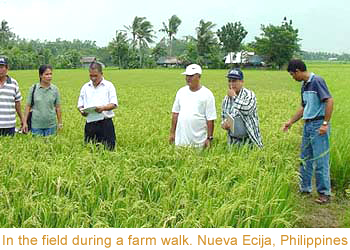Running farmer-led demonstrations: The farm walk
What is a Farm Walk?
A Farm Walk is a field demonstration established by farmers, and led by farmers for other farmers. (They are supported by researchers and/or extension workers).
Why a Farm Walk?
Farmers believe other farmers. With this in mind, a Farm Walk allows farmers to highlight their own experiences with other farmers about the pros and cons of “new” technologies. While researcher-led demonstrations can raise awareness, farmer-led demonstrations are more believable to other farmers.
Establishing and conducting a Farm Walk
Establishing needs and opportunities: Step 1 is to make sure true farmers needs are being addressed. Thus a “Needs and Opportunity Assessment” is undertaken to identify problems, their root causes and thus to identify farmer acceptable options for overcoming the problems. If necessary, new options are first demonstrated to farmers in researcher-led field demonstrations to raise farmer awareness about “new” technologies. Based on interaction with farmers, some farmers then choose to conduct their own on-farm demonstrations – or “Farm Walks”.
Training: If required, farmer collaborators receive training in key aspects of the new technology to make sure that the technology is understood and applied correctly.
Establishing the Farm Walk field demonstration:
- Farmers establish the new practice in part of their fields only.
- Fields should have good easy access
- Good visibility: Fields should be visible from the road and have a sign indicating what is being done and who can be contacted for further information;
- Fields should be established to clearly demonstrate the differences between the new practice and existing farmer practice. Having the demonstration in a corner or alongside another field works well for comparison purposes.
- Plots should be large enough to be believable e.g., minimum 10 m x 10 m. Fields should be representative of fields in the area
- Have a sign posted showing:
- What’s being tested
- Who to contact
- Fields should be visited during the season by researchers and or the extension workers to note any farmer innovations and/or to see what problems may be arising – either through incorrect application of the technology or due to unforeseen circumstances. Conducting the Farm walk: The researcher and/or extension workers should visit the sites the day before the farm walk and discuss what the plots show with the farmers;
- It may be necessary to provide some refreshments and a plan whether farmers will move to different sites and if so, how?
- Demonstration and explanation of the plots should be farmer led (and researcher supported);
- Be prepared to accept criticism of the technology – do not stifle this, as the farmers need to see you are genuinely interested in their perspectives. Use feedback to improve such as – "what’s the problem – the technology or understanding of the technology?",
- Use farm walks to informally (and in a non-threatening manner) collect feedback on technology and farmer needs such as – "what do they like? What are their farming needs? Would they use the technology – if not, why?",
- Be prepared to accept questions outside the area of technology being tested.
- Move general discussion to areas where all participants can see and hear. If possible hold discussions under shaded areas of the field.
- If necessary provide a portable loudspeaker system or megaphone
